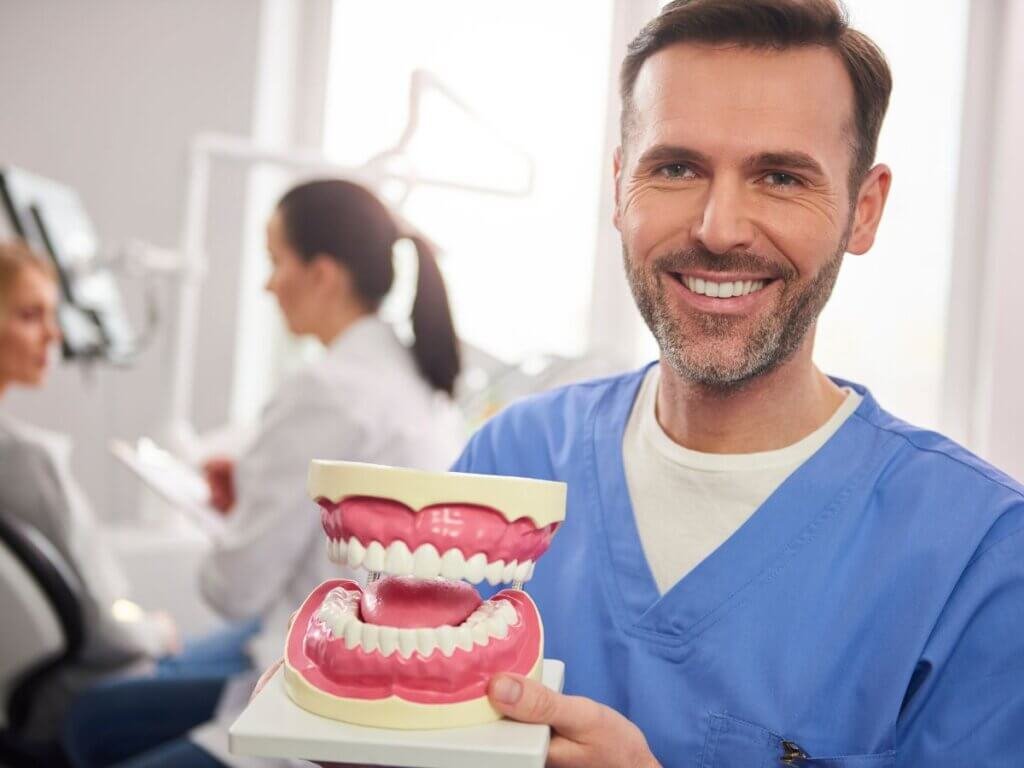Have you ever chipped or weakened a tooth and wondered how dentists manage to fix it so perfectly that it looks and feels like your natural tooth?
Modern dentistry has made that possible through dental crowns , an advanced restorative solution designed to protect, strengthen, and enhance damaged teeth.
A dental crown doesn’t just improve how your tooth looks; it also restores its strength and functionality so you can chew and smile comfortably again.
While the process of getting a dental crown might sound complex, it actually follows a clear and structured series of steps that combine dental science, technology, and artistry. Each stage is vital to ensure the final crown fits perfectly and lasts for years.
Understanding these steps helps you know what to expect and makes the treatment journey smoother and more reassuring.Let’s take a closer look at how a dentist creates and places a crown that restores both your tooth and your confidence.
Understanding What a Dental Crown Is
A dental crown is a custom-made cap that covers the entire visible portion of a damaged, decayed, or weakened tooth. Its purpose is to restore the tooth’s shape, strength, and natural appearance.
Crowns are made from a variety of materials, such as porcelain, ceramic, metal, or zirconia. The choice depends on the tooth’s location, the patient’s aesthetic preferences, and the dentist’s recommendation.
If you’re considering getting one, consulting an expert dentist in Bangalore ensures you receive a crown that’s both durable and naturally matches your smile.Dentists often recommend crowns for several reasons.
You might need one if your tooth has a large cavity that a filling can’t repair, if it has been weakened after a root canal, or if it’s cracked due to injury. Crowns are also used to cover dental implants or to anchor a bridge that replaces missing teeth.
In restorative dentistry, Dental Crowns and Bridges often go hand-in-hand. Crowns are placed on existing teeth or implants, while bridges use crowns as support to hold an artificial tooth in place.
Together, they restore both the function and beauty of your smile. A well-crafted dental crown blends seamlessly with your natural teeth, helping you bite, speak, and smile without discomfort or embarrassment.
Step 1 – Initial Consultation and Dental Examination
Your journey toward getting a dental crown begins with a thorough consultation. During this visit, your dentist will examine the tooth that needs restoration and take X-rays to evaluate the roots, bone structure, and overall oral health.
The goal is to determine whether a crown is the most suitable treatment option or if other procedures are needed first, such as a root canal or filling.
The dentist will also discuss your dental history, daily habits, and preferences. You’ll learn about different crown materials,such as all-ceramic, porcelain-fused-to-metal, or all-metal crowns,and their respective benefits.
Each material has its advantages: ceramic crowns are more natural-looking, while metal crowns are highly durable and ideal for molars.
Once the evaluation is complete, your dentist will create a treatment plan. This plan outlines each stage of the process, including tooth preparation, temporary restoration, and the final crown placement.
In cities like Bangalore, advanced clinics often use digital imaging tools to provide precise and comfortable assessments. These tools allow your dentist to show you a visual preview of how your restored tooth will look once the crown is placed.
Step 2 – Tooth Preparation and Impression Taking
After the initial consultation, the next step is preparing the tooth to receive the crown. This involves reshaping the tooth by removing a thin layer of enamel to make room for the crown. The amount of tooth structure removed depends on the type of crown being placed.
For example, porcelain crowns need slightly more space than metal ones because of their thickness.This procedure is performed under local anesthesia to ensure complete comfort.
You won’t feel any pain during the preparation. Once the tooth is reshaped, your dentist will take an impression of the prepared tooth and surrounding teeth.
Traditionally, impressions were made using a soft putty material, but many modern dental practices now use digital scanners that create 3D models. These scans are more accurate and comfortable, eliminating the need for messy impression materials.
The impression or digital scan serves as a blueprint for the dental lab to create your custom crown. Since this process takes a little time, your dentist will place a temporary crown made of acrylic or composite resin to protect your tooth.
This temporary crown helps maintain the tooth’s position, allows you to chew gently, and prevents sensitivity until your permanent crown is ready.
Step 3 – Crown Fabrication in the Dental Lab
Once your impressions are sent to the dental lab, skilled technicians begin crafting your crown. This step is essential because the crown must match your natural tooth’s color, size, and shape.
The technicians use high-quality materials and advanced techniques to create a restoration that blends perfectly with your existing teeth.
The choice of material plays an important role here. Porcelain and ceramic crowns are preferred for front teeth due to their lifelike translucency, while metal and zirconia crowns are chosen for back teeth because of their strength and durability.
Some patients also opt for porcelain-fused-to-metal crowns, which provide both strength and aesthetics.The fabrication process typically takes one to two weeks.
During this time, precision work ensures that your crown fits comfortably and aligns with your bite. Every edge and contour is carefully shaped to match your unique dental anatomy.
When it’s ready, the crown is polished and glazed to give it a natural sheen, making it indistinguishable from the surrounding teeth.

Step 4 – Fitting and Adjusting the Permanent Crown
Once your permanent crown is ready, you’ll return to the clinic for the fitting appointment. The dentist begins by removing the temporary crown and cleaning the tooth underneath.
Then, they place the permanent crown on your tooth to check its fit and alignment.This step is crucial because even the smallest misalignment can affect your bite or cause discomfort.
The dentist evaluates how the crown feels when you bite down and makes necessary adjustments to the shape or surface. The color of the crown is also checked under natural lighting to ensure it blends seamlessly with your other teeth.
The fitting process usually takes about 30 to 60 minutes. If the crown fits perfectly and feels comfortable, the dentist proceeds to the next step,cementing it permanently.
However, if any fine-tuning is required, minor adjustments can be made right in the office to guarantee the best possible result.
Step 5 – Cementing the Crown in Place
After confirming the crown’s fit and comfort, the dentist permanently attaches it using a strong dental cement.
The cement is applied inside the crown, which is then carefully placed over the prepared tooth. The dentist applies gentle pressure to position it precisely and removes any excess cement around the edges.
Once the cement sets, your new crown becomes a permanent part of your tooth structure. Your dentist will check your bite again to make sure everything feels balanced.
You may be advised to avoid eating for at least one hour after the procedure, allowing the cement to harden fully.It’s normal to experience slight sensitivity for a few days after placement, especially to hot or cold foods.
This discomfort is temporary and usually fades quickly as your gums and teeth adjust to the new crown. Once fully set, your crown will function just like a natural tooth, giving you the confidence to eat, speak, and smile comfortably.
Step 6 – Follow-Up and Long-Term Care
Getting a dental crown doesn’t end when the procedure is complete. Proper maintenance and regular follow-ups are key to ensuring it lasts for many years.
Your dentist will schedule a follow-up appointment a few weeks after placement to check the crown’s condition and your comfort level.
To keep your crown in excellent shape, maintain a consistent oral hygiene routine. Brush twice daily with fluoride toothpaste and a soft-bristled toothbrush to avoid scratching the crown’s surface.
Floss carefully around the crown to remove food particles and plaque, but avoid snapping the floss against the gumline.Try to avoid chewing on hard foods like ice or hard candies, which can damage the crown.
If you grind your teeth at night, your dentist might recommend a mouthguard to protect both your crown and your natural teeth. With proper care, dental crowns can last 10 to 15 years or even longer.
If you’re in Bangalore, you’ll find that dental clinics offering advanced crown treatments use modern materials and techniques that extend the crown’s lifespan.
Regular checkups allow your dentist to detect any wear, cracks, or gum issues early, ensuring your restoration continues to perform well for years.
Combining Crowns and Bridges for Full Restoration
In many restorative cases, a dental crown is used together with a bridge to replace missing teeth.Crowns and dental Bridges work in harmony to restore both function and appearance.
A bridge consists of one or more artificial teeth (called pontics) that fill the gap left by missing teeth. These pontics are supported by crowns placed on the teeth adjacent to the gap.
This combination is highly effective in maintaining bite alignment, preventing neighboring teeth from shifting, and improving chewing efficiency.
For example, if a patient loses a molar, a bridge supported by crowns on either side can replace the missing tooth seamlessly. This setup provides a stable, natural-looking solution that feels as comfortable as your original teeth.
Crowns and bridges also protect your jaw alignment and prevent uneven wear on other teeth. They not only restore functionality but also enhance your overall oral health, allowing you to smile with confidence once again.
Life After Getting a Dental Crown
Life with a dental crown feels remarkably natural after a short adjustment period. Most patients report that their new crown feels and functions just like their original tooth. You can enjoy your favorite foods again, speak clearly, and smile without hesitation.
Crowns are stain-resistant and durable, meaning they maintain their appearance for many years with minimal care. However, while crowns are strong, they’re not indestructible.
You should still treat them with the same care as your natural teeth,avoid biting hard objects or using your teeth to open packages.If your dental crown ever feels loose, chipped, or causes discomfort, contact your dentist promptly.
Early attention can prevent more serious damage and preserve your crown’s longevity. In general, crowns require little maintenance beyond good oral hygiene and routine checkups.
A crown doesn’t just repair a damaged tooth,it restores your confidence, comfort, and the natural beauty of your smile. Patients often find that after getting a crown, they smile more freely and enjoy a renewed sense of dental well-being.
Conclusion
Getting a dental crown involves several key steps, each carefully designed to restore your tooth’s health, appearance, and function. From the initial consultation and tooth preparation to the final fitting and cementing, every stage contributes to creating a restoration that feels completely natural.
Though the process may take a couple of visits, the result is worth the effort: a strong, durable crown that can last for many years with proper care. If you’re considering restorative dental treatment in Bangalore, trust Dentistree Advanced Dental & Implant Center for expert, patient-focused care.
Their experienced team combines precision, technology, and artistry to craft crowns and bridges that enhance both your oral health and your smile.
Whether you need a single crown or a complete restoration, you can count on their commitment to making each step comfortable and effective,helping you enjoy a healthier, more confident smile every day.
Sources:

Dr. Samreen Farrah Siddiqui is a compassionate and experienced dental professional dedicated to providing exceptional oral care. A trusted dentist in Bangalore, she is the founder of Dentistrée Advanced Dental Center in Bangalore, offering a wide range of treatments, including general, orthodontic, restorative, and cosmetic dentistry. With a strong commitment to ethical practice and long-term oral health, Dr. Samreen Farrah Siddiqui ensures every patient receives personalised, high-quality dental care in a welcoming environment.






